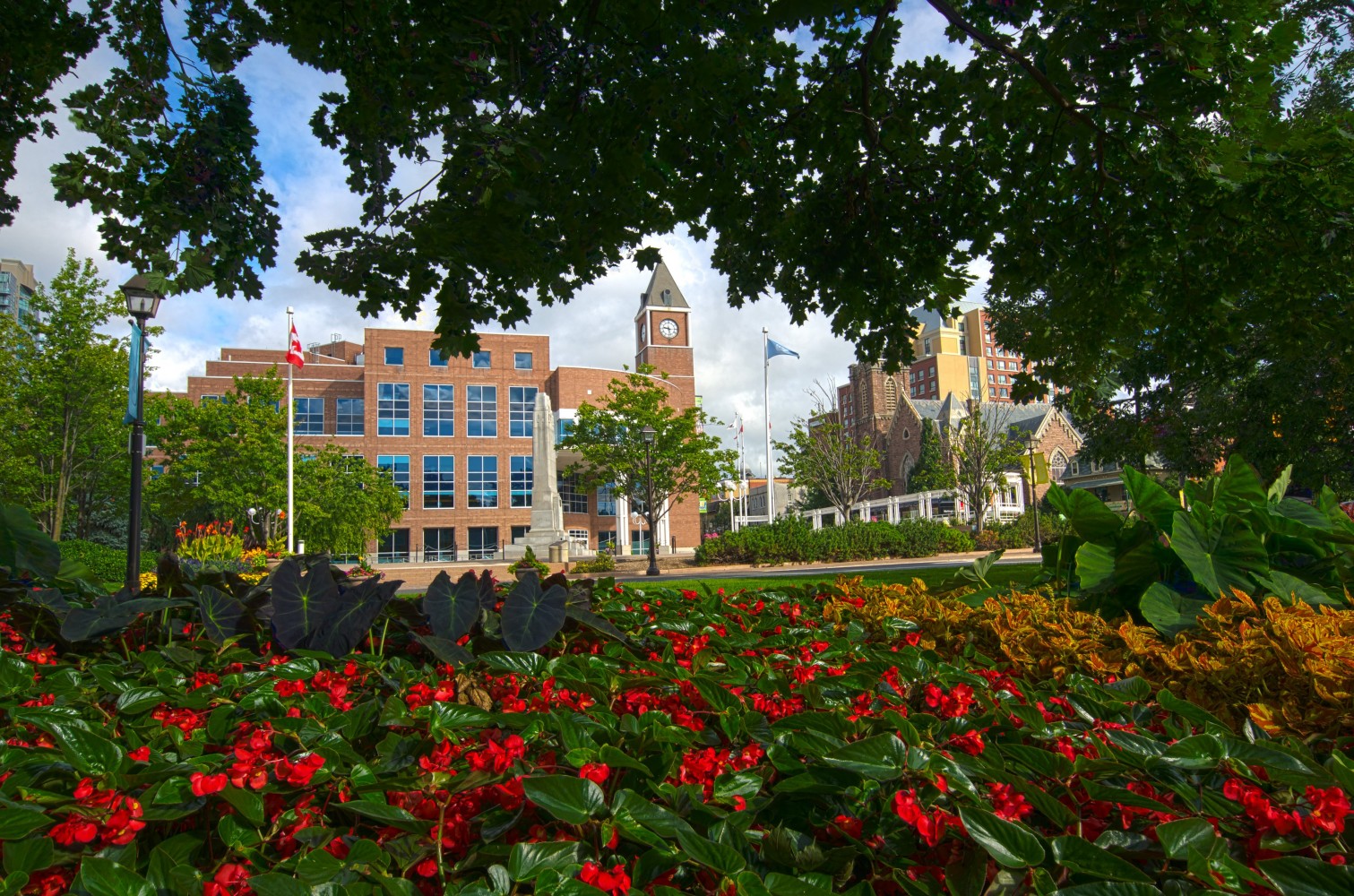
Brampton’s battered finances could put an end to recent tax freezes
Brampton has a splitting financial headache.
After a decade of mismanagement at City Hall, the current Council inherited an almost impossible situation.
Major infrastructure work has been neglected and projects desperately needed to move the city forward are piling up, but many property owners were growing weary of sharp tax increases that brought few major improvements.
Brampton is the largest city in Canada without a full stand-alone university campus, it only has one full-service hospital, its light rail transit dream remains unfunded, same with a massive project to fix the decades-long floodplain issue that has led to the decay of its dilapidated downtown area.
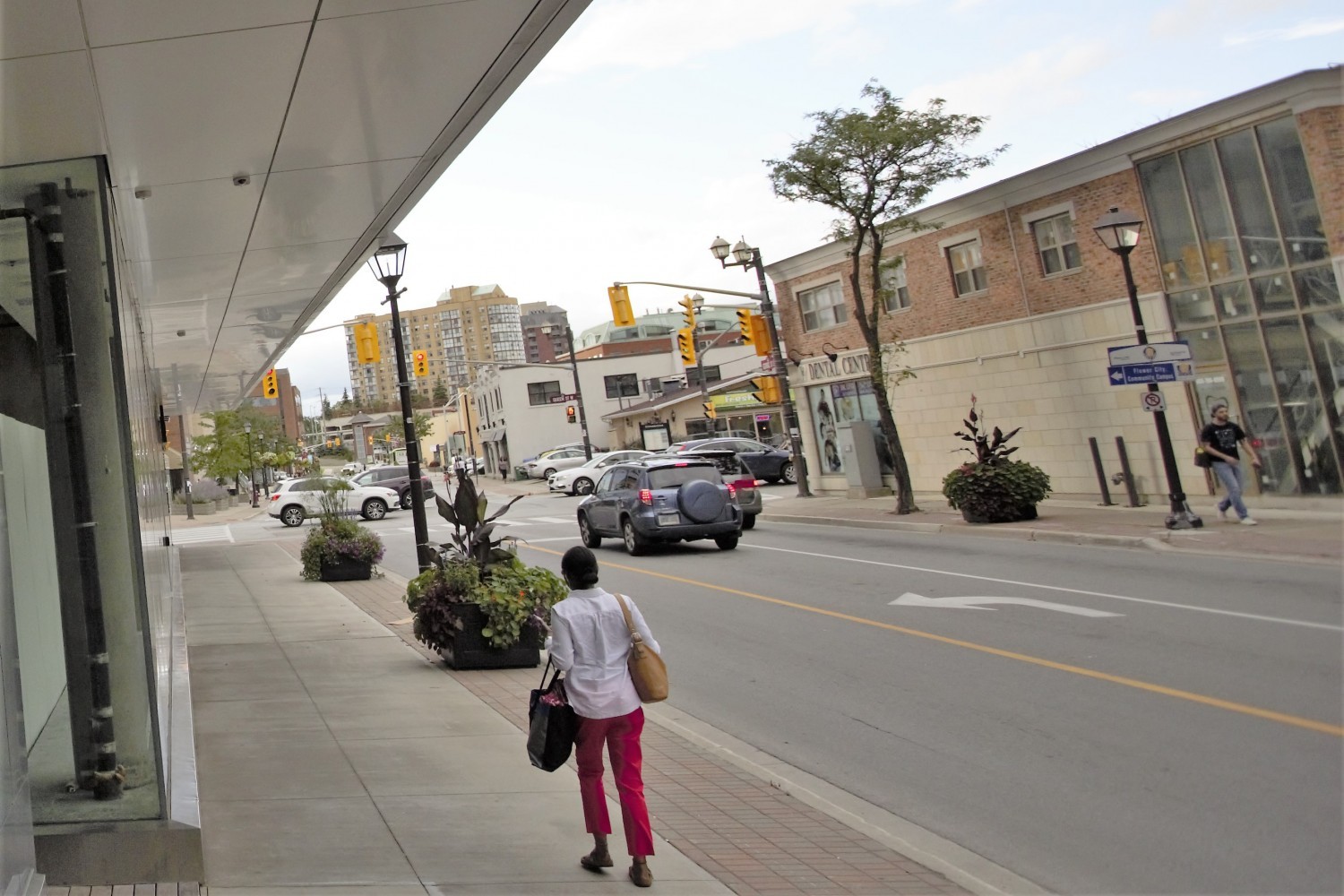
Financial pressure from COVID could impact investment across the city, something particularly problematic for areas in desperate need of investment, like downtown.
Mayor Patrick Brown has chosen to ignore these needs, opting instead to freeze taxes to give residents a financial break. It has come at the expense of improving a city in need of a boost to its reputation after decades of sprawling development, rising violent crime statistics usually associated with municipalities on the decline and terrible leadership at City Hall.
An external report was commissioned in late 2014 shortly after former mayor Susan Fennell was handed a resounding defeat by Brampton voters following years of deplorable financial stewardship under her watch. It was conducted by former Ontario auditor general Jim McCarter, who found the City’s finances were a mess.
“[T]he City’s financial flexibility has deteriorated over the past five to 10 years, and there are a number of issues that City decision-makers need to keep in mind on a go-forward basis,” he wrote.
The CD Howe Institute ranked Brampton dead last in municipal budgeting accuracy when it conducted an extensive national study that looked at financial performance from 2001 to 2010. The city’s budgets were off by more than 51 percent, when comparing the approved budgets at the beginning of the year with the actual numbers at the end, which reflect the financial reality of what revenue came in and how much money had to be spent to meet all needs. Toronto, by comparison, was only off by 5 percent, on average, over the same time period. No city was even close to the poor performance of Brampton. Vaughan had the second worst performance, with an inaccuracy rate of 21.6 percent.
It’s hard to imagine a household budgeting a certain amount for its annual needs at the start of the year, and by the end finding out its best calculations were off by more than 50 percent.
After it became clear that Fennell and former budget chair Gael Miles were incompetent, spending their attention on matters they were tied to personally, the low point came in early 2014, when it was revealed the City could not account for $704 million in approved projects, many that were never even started, over a seven-year period. It left some councillors in disbelief and residents furious over the spectacular mismanagement.
Then, in 2017, the city was left stunned when an internal audit department investigation under Fennell’s successor, Linda Jeffrey, revealed senior staff during the leadership of former city manager Deborah Dubenofsky and Fennell had been paid $1.25 million in a secret “slush fund” scheme that was never made public and done without council’s knowledge. When she found out about it years later, Jeffrey said, “This is at best serious negligence, and at worst corruption.” Though the staff names were never revealed, almost all the senior bureaucrats under Fennell were either fired after Jeffrey became mayor or, in Dubenofsky’s case, her contract was not renewed in 2012.
After Fennell’s ouster McCarter found that money going to City staff for salaries and benefits was far outpacing Brampton’s ability to pay for the skyrocketing labour costs. About 96 percent of increased property tax revenues from booming growth over the prior decade had been used to fund City Hall salaries, instead of investments in Brampton’s infrastructure and future projects, McCarter revealed.
While the city desperately needed a facelift, taxpayers were unwittingly putting most of their hard earned money into the bank accounts of municipal staff.
It brings us back to the present.
After Council finalized the 2020 budget back in February, it seemed discussions for the 2021 budget had already begun. A new outline has to be presented to the public in November, but no one could have imagined the financial impact of a global pandemic in a city already reeling from more than a decade of mismanagement.
Brown has promised fiscal restraint, part of his Conservative philosophy, and has decided to set aside crucial needs in order to give taxpayers relief. Though the City’s tax rate is in line with the average rate across the 905, the mayor has chosen the popular route of many other Conservative politicians. Despite the downtown’s desperate need for infrastructure work and a complete remake, he oversaw the cancellation of the ambitious Downtown Reimagined project, shortly after taking office. Though as much as $50 million was saved, the area has fallen into further decay and many downtown business owners are demanding a minimum investment in the city centre.
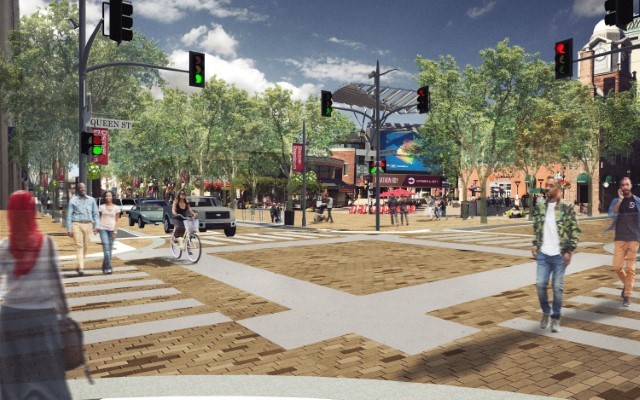
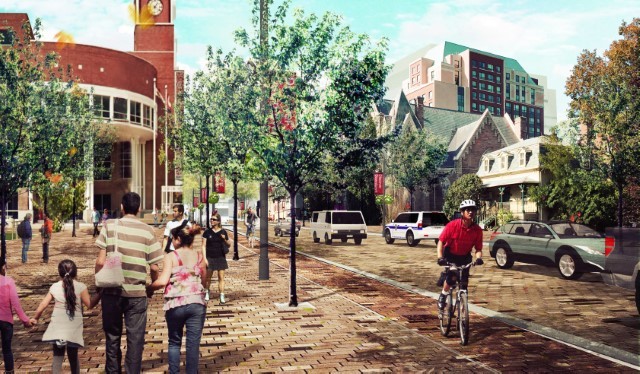
The Downtown Reimagined project, meant to transform the city centre's streetscape, has been delayed continuously by a lack of money to pay for the project.
Brown also had more than $200 million cut from the current capital budget for this year, after the 2019 budget had included a $431 million projection for projects and other needs in 2020. Crucial infrastructure work, such as a major transit facility needed to accommodate rapid growth in the system, was postponed.
Even though Brown knows his tax freezes are wildly popular, they only put the city further behind. He has made the moves while also promising a brand new major university, expanded healthcare, an LRT extension and other desperately needed features the city is lacking.
And now, raising more questions around Brown’s math, as his revenue plan doesn’t match up with his other promises, the pandemic is posing even more challenges.
If a return to a pre-COVID world were to happen by October 1, the City says it will face a $51 million deficit, according to projections it released in April.
It was recently announced that Brampton will receive $35 million from the provincial and federal governments as part of the funding that has been allocated to help municipalities address pandemic-related shortfalls.
The City says there are sufficient funds in the General Rate Stabilization reserve account to cover the losses left over after the assistance. If normal services resume by the new year, the City will have a near $55 million deficit, but most of it will be covered by the aid, leaving about $20 million that taxpayers might have to burden. The projections include any money the city saved from layoffs and any other cuts that were made.
Mayor Patrick Brown says it is too early to judge whether Bramptonians will see a third straight tax freeze, but noted he does not want to place the financial burden of COVID-19 on local residents.
Since the onset of the pandemic, uncertainty as to whether higher levels of government would help left the City in a difficult position. But that changed when the announcement was made earlier this month that Brampton will be receiving $35 million from a partnership between the federal and provincial government to help municipalities address the financial stress caused by COVID-19. Of this, $11 million is for general municipal funds and about $24 million is allocated for transit.
The City told The Pointer the timeline and figures reflect the end of four quarters, typical reporting points for staff.
Increasing property taxes for the new year will be one way the City could address its ongoing financial concerns. But it’s not clear if Brown wants to do this, even if Brampton is in dire need of a revenue infusion. It can’t afford to leave more projects unfunded, further postpone others and ignore needs such as the downtown renewal and a new full-service hospital, which would demand a municipal contribution that has yet to be committed.
The Pointer asked Brown if he would be advocating for another tax freeze this year. He didn’t rule out the option. He said the virus hasn't posed financial difficulty for the city only, but for its residents as well. Any discussions on a tax freeze at this time are “premature,” Brown said.
“The only thing I would say is that when we do get into budget discussions, I'm mindful of the fact that there's already been significant financial challenge put on the backs of Brampton residents. This has been a very difficult year and if it’s possible, I certainly wouldn't want to put any additional financial hardship on the backs of Bramptonians. But you know, we're not there yet,” he said Wednesday.
If a tax freeze is approved, it will be the third consecutive one since Brown took office in 2018, exacerbating growth and infrastructure challenges the city was already facing before the financial impact of COVID-19. According to the 2019 State of Local Infrastructure (SOLI) report, the city’s infrastructure gap is $337 million. Brampton’s 2019 draft budget put this number at $246 million.
“The growing infrastructure gap is mainly attributed to the insufficient investments planned for Transportation and Parks services. It is important to recognize that much of the accumulated infrastructure gap is associated with the existing backlog of “overdue” infrastructure requirements in 2019 and 2020,” the report says.
The financial gap is highlighted alongside other features that need attention in the next capital budget. These include 40 percent of the city’s fire equipment and 10 percent of vehicles for fire service, with the report stating the costs for these needed investments will “likely be addressed in the short-term through the city’s regular capital budgeting process.”
The infrastructure gap was growing long before the presentation of the City’s second tax freeze this year. The 2020 budget was $977 million, with $755 million for the operating budget and $222 million for the capital budget. Three potential tax freezes would not be in line with the City’s financial master plan, which states a tax increase of 3 to 5 percent is needed to manage Brampton’s basic needs. Under this reasoning, not even a single tax freeze should have been pushed.
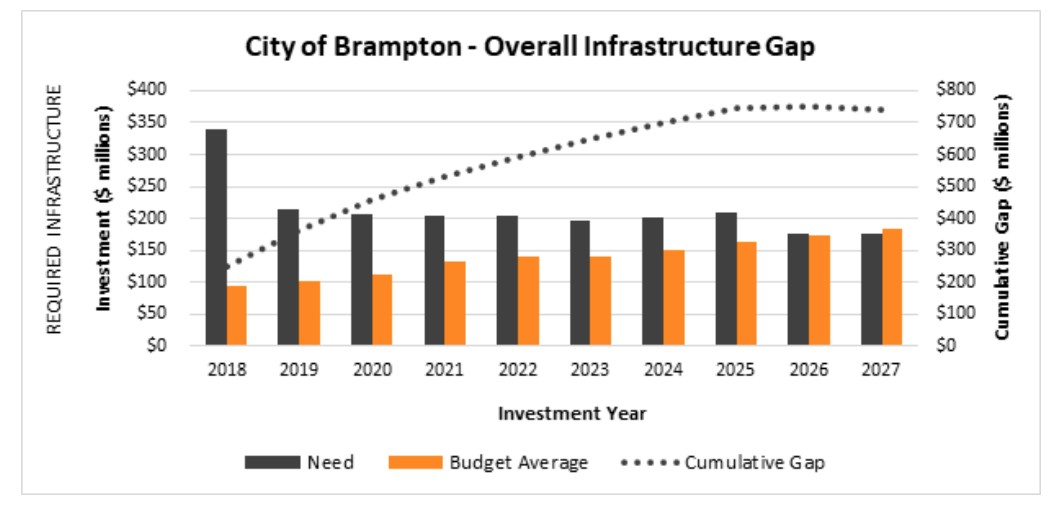
Even with continued investment, the city's infrastructure gap is projected to grow over much of the next decade.
But Brown has been rumoured to be interested in furthering his political career, as evidenced by his recent campaigning for failed federal Conservative leadership candidate Peter MacKay, and tax freezes look good on a political resume.
He has aggressively pushed to have them on his Brampton resume.
The 2020 capital budget saw a 41 percent decrease towards the initial 2020 projection that was presented, which put the capital budget at $431.5 million. A $175 million transit storage facility was moved from the 2020 budget to the 2021 budget along with $50 million for the widening of Williams Parkway. It’s not clear at this time if funding for the projects will be put off for another year because of the financial pressure brought on by COVID-19 and another tax freeze the city can’t afford.
The funds from higher levels of government will not cover the projected deficit in full. While municipalities have an option to apply for a second round of funding, it’s not clear how much they will receive. According to Gary Kent, the commissioner of corporate services and chief financial officer for the City of Mississauga, a handful of factors will likely be considered. These include what municipalities have done to reduce financial pressure, how Phase 1 funding was used and what the financial situation looks like for the municipality come September 30. The City of Brampton said any financial shortfalls that aren’t resolved from the second phase of funding will have to be “considered through 2021 budget deliberations.”
It’s unclear if another tax freeze would hurt the City’s chances of getting more aid from the higher levels of government, which might be concerned if Brampton is essentially unwilling to raise its own tax revenues, while looking for help from Ottawa and Queen’s Park.
One of the most crucial aspects of the budget will likely focus on how the reserves can be built back up if money has to be drained. The 2015 McCarter report highlighted how reserve accounts had not been sufficiently increased, a trend that has continued, and now faces more headwinds due to the pandemic. To get reserves to a healthy balance, City staff shared two possible options with council in July: a one percent property tax levy each year over the next decade, or a 10 percent tax levy in 2021. This levy will only address the reserve fund issue, according to the staff report, and not any outstanding funding issues related to the projected deficit.
The option for no increase to the property tax is also being examined, but it’s unclear what Council, and Brown specifically, will be willing to sacrifice, this time.
“Given the severe economic impacts related to COVID-19, it is reasonable to expect that future Assessment Growth will be limited, which will impact the amount of funding available for growth in City operations,” the staff report said.
City staff will present a forecast on the operating budget sometime in September. The proposed 2021 budget document will be released to the public November 2 and deliberations will start later that month. The budget is expected to be approved on December 9.
Email: [email protected]
Twitter: @nida_zafar
Tel: 416 890-7643
COVID-19 is impacting all Canadians. At a time when vital public information is needed by everyone, The Pointer has taken down our paywall on all stories relating to the pandemic and those of public interest to ensure every resident of Brampton and Mississauga has access to the facts. For those who are able, we encourage you to consider a subscription. This will help us report on important public interest issues the community needs to know about now more than ever. You can register for a 30-day free trial HERE. Thereafter, The Pointer will charge $10 a month and you can cancel any time right on the website. Thank you.
Submit a correction about this story


